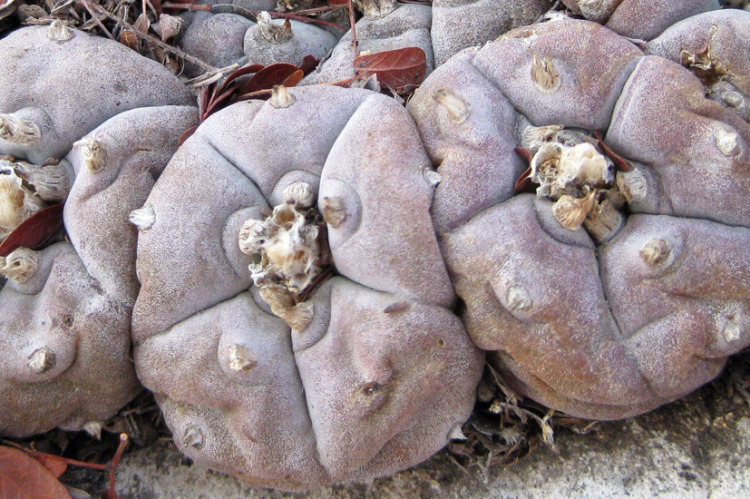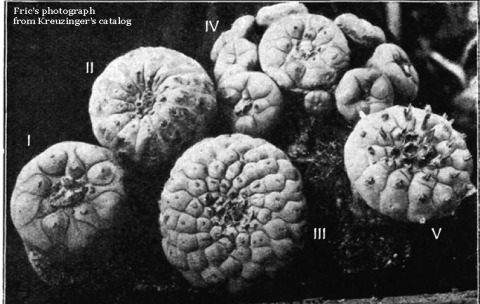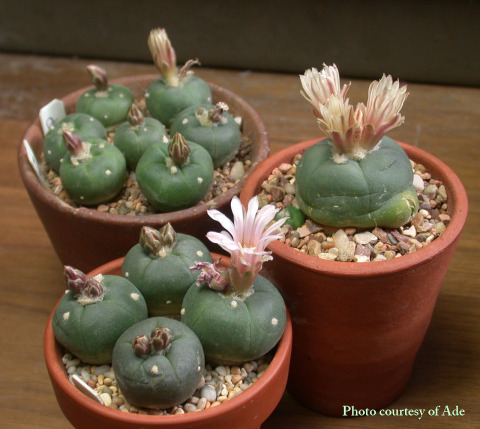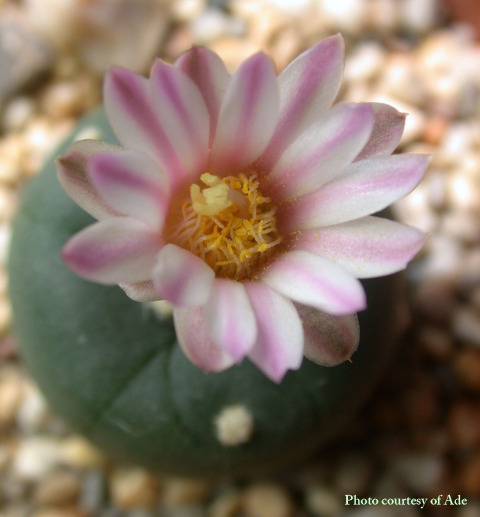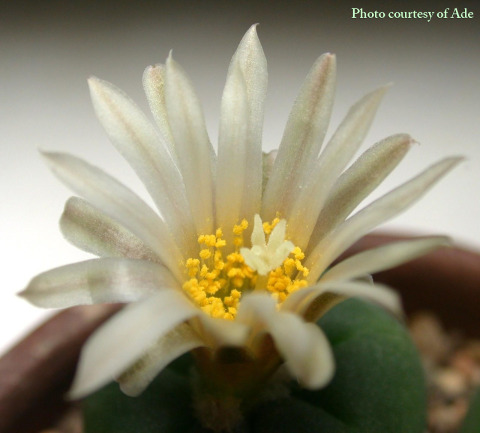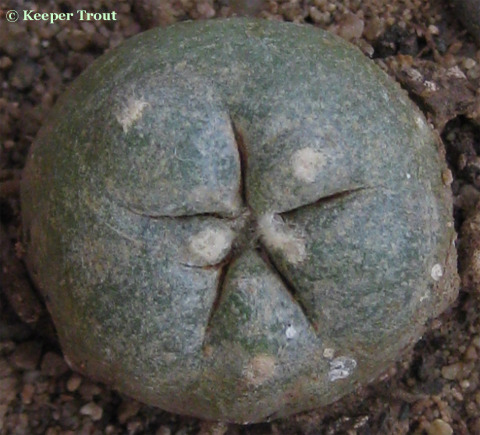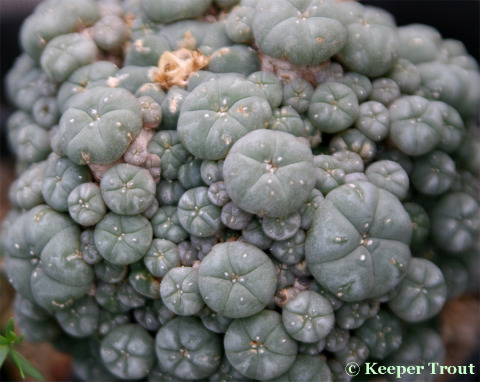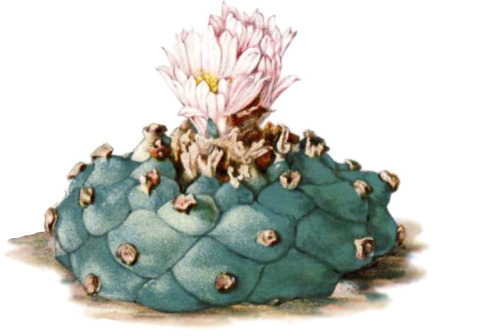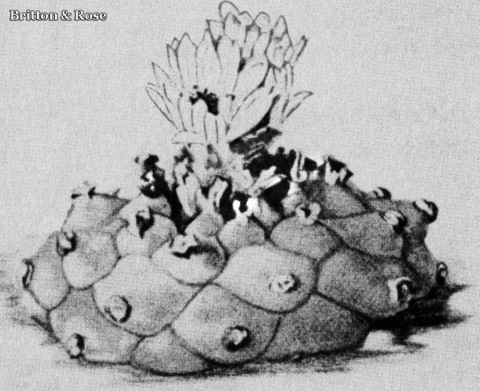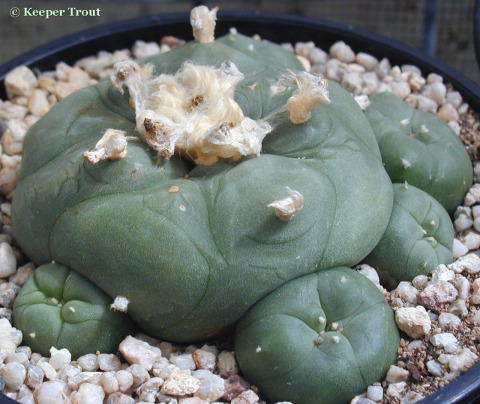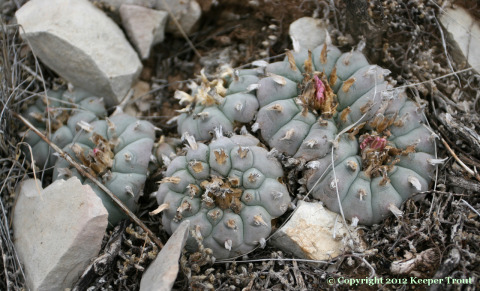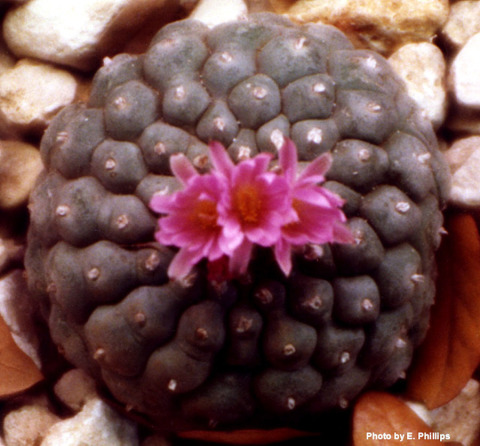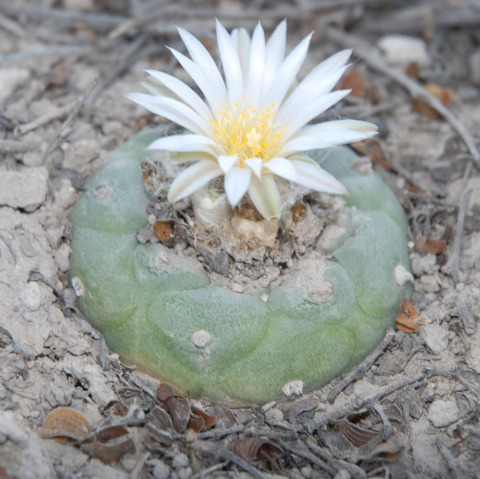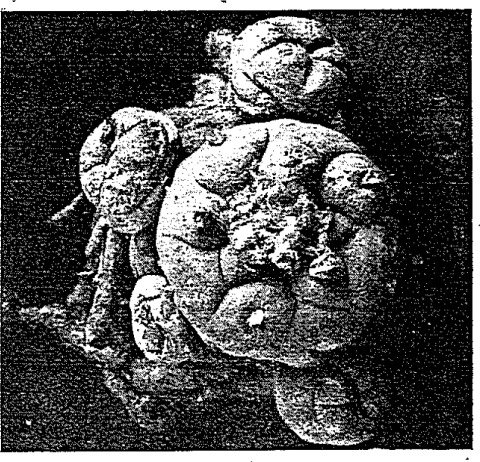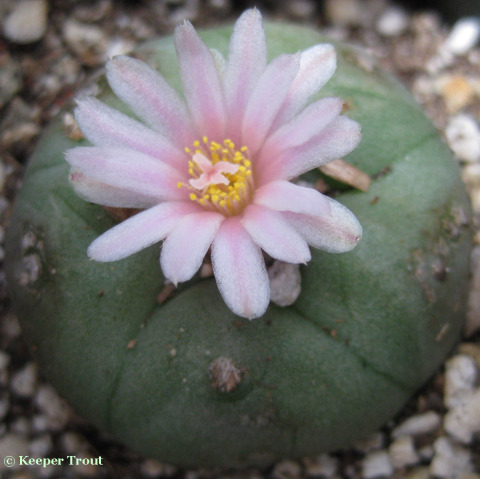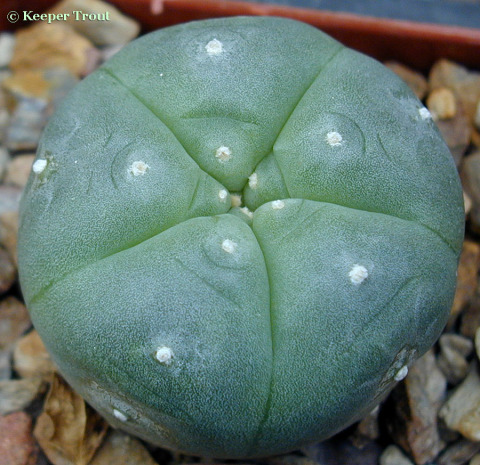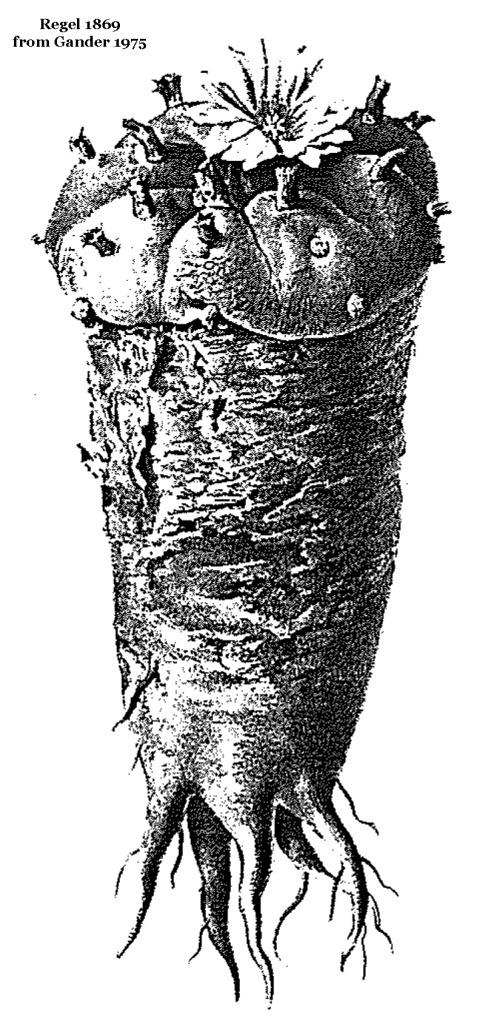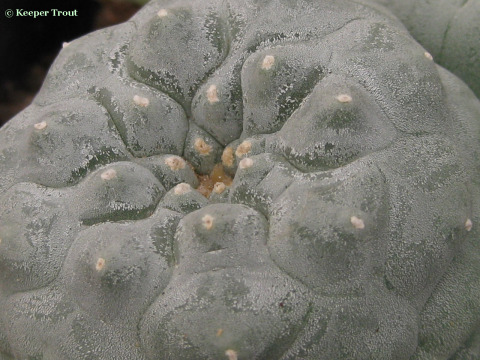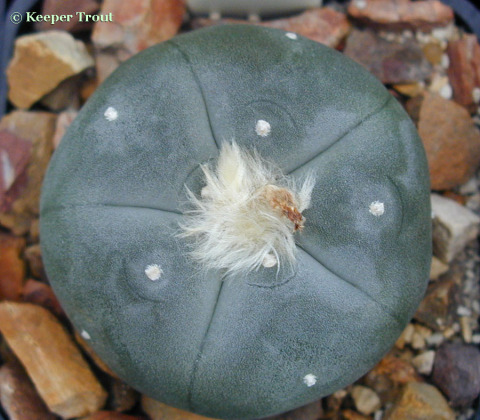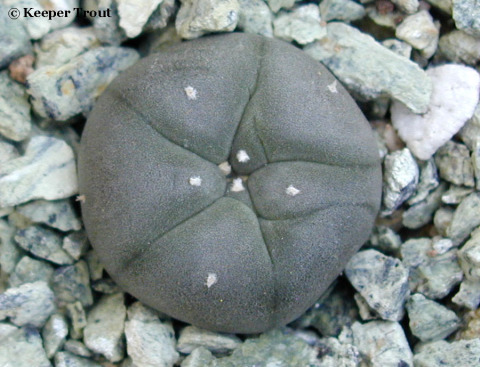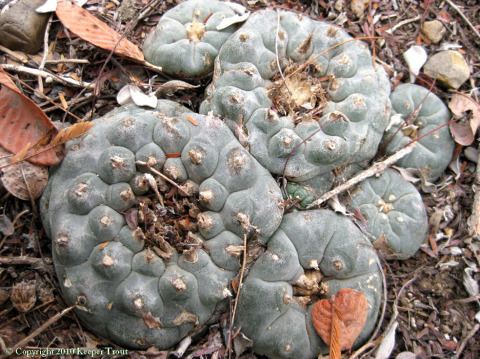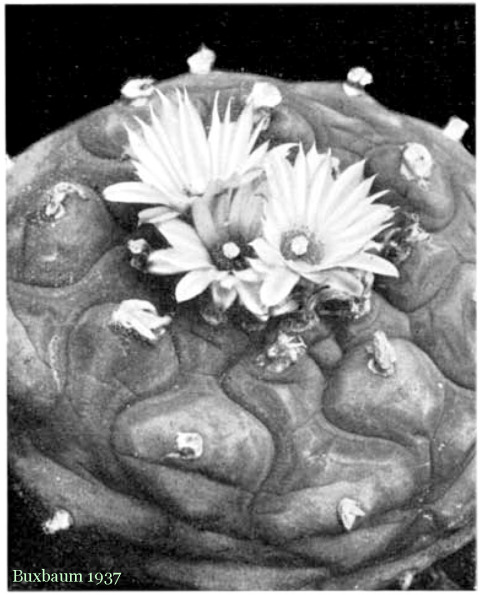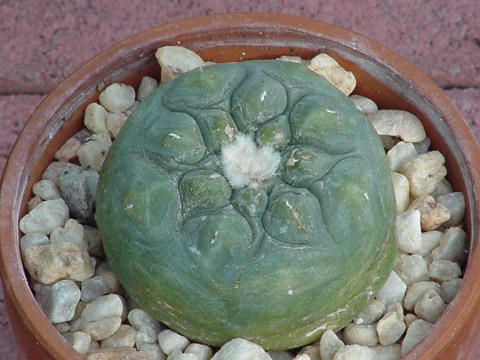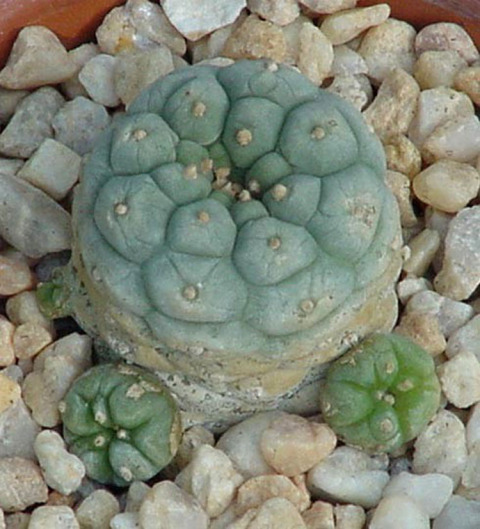The Lophophoras
A.V. Frič’s view of Lophophora in 1936
I “Lewinii (Hennings) blaßgelb Blüten” Keep this image in mind. We are going to refer to it again later. In Frič’s earlier use of this image, in 1924, he labelled this sp. lutea Frič. Frič should have kept it as sp. lutea.
II “texana“
III “Williamsii (Lem.) blaßrosa Blüten” In its first appearance, in Frič 1924, this was Anhalonium sp. fl. rosea Frič. (This became Lophophora williamsii var. decipiens in Backeberg 1961.) Fric’s account enabled Denis Cowper to locate it; it is now Lophophora fricii.
IV “caespitosa (San Luis)”
V “Jourdaniana (syn. violaciflora) violetrosa Blüten.” In 1924, Frič had this image labelled as “Lewinii“.
Many Lophophora species names have appeared in print. Most of those are horticultural or sometimes they are erroneous. In earlier editions of this book, the problem names that were discussed were lumped together into one confusing section. In the present arrangement they are being treated separately in alphabetical order.
Many other ‘species’ and varieties have been proposed due to peyote’s highly variable nature. There seems little point in discussing them all. They are simply forms and many of them can be found within any large single population of peyote. Anderson and Grym have summarized them, and why they should be rejected, very nicely. For instance please compare the L. williamsii pictured elsewhere herein with Lophophora texensis below. Bohata and coworkers 2005 have treated the genus Lophophora quite excellently and readers interested in detailed information about the Lophophora species (including many great habitat photographs) are directed to their special issue of Kaktusy.
It seems obvious that most of the world’s experts now agree that five actual species presently exist, L. williamsii, L. koehresii, L. fricii, L. diffusa and the most recent species L. alberto-vojtechii. More may possibly be defined in Mexico in the future. The actual face of the genus is still being worked out and it seems likely that a number of varietal descriptions will find acceptance.
There also may be another variety or form of L. williamsii, most often confusedly known as L. williamsii var. echinata sensu Weniger. It will be touched on in its own section but will be included with more detail and images in the discussion of L. williamsii. It is somewhat distinct from a typical L. williamsii in its form, environmental tolerances and chemical make-up. Whether this qualifies it as an actual species seems doubtful but my thought is that it certainly merits some sort of recognition.
There is of course that pesky issue that, for plants at least, the concept of species is curiously defined with some nebulosity. Lacking a clear definition of what it takes to be regarded as an individual cactus species, let’s have a look at some of the names of interest.
Parenthetical names (Kanji) may be found helpful in performing online searches for additional imagery.
Lophophora alberto-vojtechii (小型烏羽玉)
This miniature plant is the newest Lophophora species. Considering how recently it has been noticed, its range in Mexico has been found to be surprisingly large. I’m going to simply mention this species; Šnicer &/or Bohata can provide more details. It presently appears to lack any analysis.
At some point this entry will be updated. My thanks to Ade for sharing the flowering images below!
Learn more about “The Littlest Lophophora” in: Bohata 2008 Cactus & Co, 2 (12): 105-117 and in Šnicer et al. 2009. [Download a 2.3 Mb PDF copy from the Cactus Conservation Institute.]
Lophophora williamsii var. caespitosa (子吹乌羽玉)
This is simply a growth form rather than a varity. This is also not one single plant line and it is not actually clear that all of them came from L. williamsii. Phytochemical analysis suggests they do not but comparative DNA work is still lacking.
Lophophora decipiens
This is not a species but is simply a growth form that occurs in at least three of the Lophophora species. In modern horticulture, it is often specifically applied as a varietal name to a Lophophora fricii as var. decipiens.
Lophophora diffusa (翠冠玉)
Lophophora echinata
This is a confused name.
Lophophora echinata var. diffusa
Lophophora echinata var. lutea
Lophophora fricii (银冠玉)
Lophophora jourdaniana (乔丹乌鱼玉 / 有刺烏羽玉)
Name is not presently accepted as it lacks any direct link to a wild population.
Lophophora koehresii (考氏乌羽玉 / 顯疣烏羽玉)
Lophophora lutea
This is a confused name.
Lophophora sp. Parras de la Fuente
This is a pink flowered Lophophora fricii.
Lophophora williamsii var. pentagona Croizat
[Note 28]
This is not a species but simply a growth form that occurs in all of the Lophophora species.
It is not clear to what degree this form shows up in any given population with youngsters. Plants and seeds sold domestically (inside of the US) under this name have often proven to be Lophophora diffusa (this is probably due to the illegality of L. williamsii in the US) but sometimes they are L. williamsii.
Lophophora williamsii “var. pentagona” above was grown from German “var. pentagona” seed; most of them do not stay like this for very long.
Published analysis for “var. pentagona”
Compare that to “L. williamsii var. typica“
[Note 29]
The pentagona name game
Have some fun! See how many of the species for these “pentagona“s that you can identify without looking at the answers.
Echinocactus rapa Fischer & Meyer ex Regal
This is another outdated name for L. williamsii that was published in 1869.
Its publication marked the third time that an illustration of peyote appeared in print. (in Sertum Petropolitanum seu Icones et Descriptiones Plantarum quae In Horto Botanico Imperiali Petropolitano Floruerent.)
This is Lophophora fricii.
This is a synonym of Lophophora koehresii.
This is a synonym of Lophophora fricii.
Lophophora texensis (大型乌羽玉)
This is also not a real species despite seeds being commercially available. It is typically just Lophophora williamsii that came from from south Texas.
Lophophora Tiegleri Werdermann
W. Taylor Marshall & Thor Methven Bock (1941) Cactacae, p. 138, comment that this “seems to be identical with” Lophophora Lewinii; giving its body color as yellowish-green with less pronounced tufts of wool and fewer & larger tubercles than on a L. Williamsii, and producing white to cream flowers.
Obviously in their view L. lewinii is L. diffusa.
L. Chavier (1953) Cactus France 38: 255, under:
“Lophophora williamsii et Tiegleri” gives as synonyms: Lewinii, Tiegleri, Ziegleri and says they have a very pale yellow flower.
The photograph shown by Chavier is clearly Lophophora diffusa despite my photocopy being too poor in quality to permit reproduction here.
Lophophora sp. Viesca/ Vieska
This is a Lophophora fricii.
Lophophora viridescens (Halda) Halda
Claimed to be a new “species”, its name appearring in the 1997 Acta Mus. Richnov. Sect. Nat. 4(2): 71. [Information from the 1998 Repertorium Plantarum Succulentarum XLIX]
This is apparently a new name for what was previously presented by Halda as L. diffusa ssp. viridescens and seems unlikely to ever gain any actual recognition as a species. More recently it was recognized as a synonym of Lophophora koehresii according to the International Plant Names Index (IPNI) online.
Lophophora williamsii (烏羽玉 / 乌羽玉)
Lophophora Ziegleri
Franz Buxbaum 1937 (in his article “Der Formenkreis de Strombocactus“) includes a photograph (fig. 26) from Backeberg taken of Lophophora Ziegleriana that is clearly a Lophophora diffusa and in line with Pizzetti’s comments. This name apparently came from Soulaire.
A common problem will soon encountered by anyone trying to sort out the different forms in horticulture: Horticultural designations of such peyote “species” and varieties are at the very least unreliably defined and may be unagreed upon between their many suppliers and growers.
Eastern Europe and Japan in particular appear to be intensive centers of not just propagation but of extensive selection and breeding for unusual characteristics. A plethora of names accompanies the output from both sources.
Crossing experiments within the genus Lophophora
Gerhard Koehres has reported successfully making the following crosses within the Lophophoras (success being judged by the production of seeds that have then been grown into actual seedlings)
Koehres noted these to be self-sterile:
L. alberto-vojtechii
L. diffusa
L. fricii
L. koehresii
L. williamsii El Huizache SLP
L. williamsii Norias del Conde SLP
Koehres listed 25 additional L. williamsii populations that he had determined were self- fertile.
L. williamsii Parras, Coahuila is said to be self fertile despite most people now placing this with L. fricii.
Koehres did not get pollination for L. koehresii using pollen from L. williamsii Huizache but found L. williamsii Huizache could be successfully pollinated using pollen from L. koehresii.
Koehres also successfully pollinated L. koehresii with pollen from L. fricii and L. diffusa. (Kada used a self-fertile L. williamsii and could get no pollination using pollen from L. diffusa, L. fricii and L. koehresii.)
L. fricii was reported by Koehres to be successfully pollinated using pollen from L. koehresii and L. diffusa. (Kada reported failures after 7 attempts involving L. diffusa pollen, 13 with L. williamsii and 18 L. koehresii pollen but reported success for 1 attempt involving a L. williamsii.)
L. diffusa was successfully pollinated by Koehres using pollen from L. koehresii. (Kada has recorded a consistent failure after 11 attempts with pollen from L. fricii, 4 with L. koehresii pollen and 3 using L. williamsii pollen.)
L. koehresii was successfully pollinated by Koehres using pollen from L. diffusa and L. fricii but not with pollen from L. williamsii Huizache (Kada reported successful pollination for 19 attempts using L. fricii pollen but none in 4 tries with L. diffusa pollen and 29 with L. williamsii pollen)
Koehres found that fruit can form from the early flowers within around 8 weeks but for the later blossoms the fruit often do not emerge until the following year. Koehres also commented that the self fertile populations are very uniform in comparison to the self sterile populations which are more highly variable in the shape of the body and the flower.
Lophophoras suspected of being hybrids
Photos by Anonymous
Folk medicinal uses of peyote are many and varied.
All species have apparently been employed for medicinal use on a local basis.
A representative few of the most common ones:
Decoction is given for fevers, the root and/or plant chewed and used as a poultice for fractures, infections, large open wounds, snake-bite and scorpion stings.
According to Landes 1963, the Potawatomis in Kansas believed it helpful for rheumatism and paralysis.
More traditional medicinal applications will be found listed within the entry for Lophophora williamsii.

